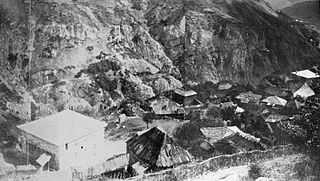
Tropojë is a municipality in Kukës County, northeastern Albania, within the historical ethnographic region of the Gjakova Highlands. The municipality consists of the administrative units of Bajram Curri, Bujan, Bytyç, Fierzë, Lekbibaj, Llugaj, Margegaj and Tropojë, that became municipal units. The seat of the municipality is the town Bajram Curri. As of the Institute of Statistics estimate from the 2011 census, there were 4,117 people residing in the municipal unit Tropojë and 20,517 in Tropojë Municipality.

Skadarska Krajina, simply known as Krajina is a geographical region in southeastern Montenegro stretching from the southern coast of Lake Skadar to the mountain of Rumija, comprising several villages. It is inhabited almost entirely by Albanians. The area is divided between the municipalities of Bar and Ulcinj.

The Luigj Gurakuqi University of Shkodër is an Albanian public university established in 1957.
Prilep, or Prejlep or Arrnjet, is a village situated in western Kosovo[a], close to Gjakova.

The Sanjak of Scutari or Sanjak of Shkodra was one of the sanjaks of the Ottoman Empire. It was established after the Ottoman Empire acquired Shkodra after the siege of Shkodra in 1478–9. It was part of the Eyalet of Rumelia until 1867, when it became a part, together with the Sanjak of Skopje, of the newly established Scutari Vilayet. In 1912 and the beginning of 1913 it was occupied by members of the Balkan League during the First Balkan War. In 1914 the territory of Sanjak of Scutari became a part of the Principality of Albania, established on the basis of the peace contract signed during the London Conference in 1913.
Linzë is a village in the former municipality of Dajt in Tirana County, Albania. At the 2015 local government reform it became part of the municipality Tirana.
Bastar-Murriz is a village in the former municipality of Zall-Bastar in Tirana County, Albania. At the 2015 local government reform it became part of the municipality Tirana.

The siege of Shkodra took place from May 1478 to April 1479 as a confrontation between the Ottoman Empire and the Venetians together with the League of Lezhe and other Albanians at Shkodra and its Rozafa Castle during the First Ottoman-Venetian War (1463–1479). Ottoman historian Franz Babinger called the siege "one of the most remarkable episodes in the struggle between the West and the Crescent". A small force of approximately 1,600 Albanian and Italian men and a much smaller number of women faced a massive Ottoman force containing artillery cast on site and an army reported to have been as many as 350,000 in number. The campaign was so important to Mehmed the Conqueror that he came personally to ensure triumph. After nineteen days of bombarding the castle walls, the Ottomans launched five successive general attacks which all ended in victory for the besieged. With dwindling resources, Mehmed attacked and defeated the smaller surrounding fortresses of Žabljak Crnojevića, Drisht, and Lezha, left a siege force to starve Shkodra into surrender, and returned to Constantinople. On January 25, 1479, Venice and Constantinople signed a peace agreement that among other concessions ceded Shkodra to the Ottoman Empire. The defenders of the citadel emigrated to Venice, whereas many Albanians from the region retreated into the mountains. Shkodra then became a seat of the newly established Ottoman sanjak, the Sanjak of Scutari. The Ottomans held the city until Montenegro captured it in April 1913, after a six-month siege.
Anton Duoda was an Albanian vice consul and merchant from Shkodër between 1706 and 1756 working for Venice. He was married to Marija Borci. Doda derived from the family today part of Tushi and Shani. In 1734, he writes that Kurt Mahmut Pasha, bey of Shkodër, traveled to his home city Gjakova. According to the Albanian newspaper Leka from 1933, in July 1733, Doda warned that the Pasha of Shkodër was planning on launching an attack on Montenegro. He sent the news to Zorzi Grimani, the General of Dalmatia. In 1735, Anton Doda thanked secretary Cromwell for the position of vice consul of Venice. In 1736, Doda writes that Shkodër has 1000 shops in the market. At the beginning of the 17th century, Doda built his house in Tophane close to the Venetian embassy in Shkodërr. In 1747 Doda practiced the system of leasing contracts for ships travelling to Venice from Ulcinj due to the fear of pirates. In 1755, Doda writes to the Venetians of Moro that an army was grazing in Catarro (Kotor) forcing Catholic Albanians to emigrate to the Ottoman Empire. He also writes about the pirates from Ulcinj in Tripoli where he states that ”no one even dares visiting the barber”. According to Doda, ”the war between the Begolli family of Peja and the Pashaliks of Gjakova had disrupted the economy of Shkodër”. Doda was fluent in Albanian, Italian, Latin, Slavic and Ottoman. According to Doda, in 1758, March 18, the border of Albania ended in Nis. He died on November 24, 1766.
Piranë is a village in Prizren municipality, Kosovo.

Bythëdosi was a historical Albanian tribe in the Middle Ages. They inhabited the Brda (Montenegro) area in central and eastern Montenegro, north-east of Podgorica.

Botushë is a village in the municipality of Gjakova, District of Gjakova, southwest Kosovo. It is located near the border with Albania and is part of the Highlands of Gjakova. It is inhabited exclusively by Albanians.
Bardhasan is a village in the Dushkaja subregion of the Gjakova municipality of Kosovo. It is inhabited exclusively by Albanians.
Zhabel is a village in the Dushkaja subregion in the Gjakova municipality of Kosovo. It is inhabited exclusively by Albanians.
Moglik or Moglica is a village in the Hasi region of the Gjakova municipality in Kosovo. It is inhabited entirely by Albanians.

Štirovica is a historical village located within the boundaries of the present-day village of Brodec in the municipality of Gostivar, North Macedonia. It is part of the region of Upper Reka.
Voksh is a village and tribal region situated in western Kosovo[a], which is inhabited by 570 people, all of whom are Albanians. The village of Voksh is also home to the Vokshi tribe which is part of the larger polyphyletic Thaçi tribe.
Vraniq is a village in District of Gjakova, Kosovo. Vraniq is situated nearby to the villages Beci and Doblibare. The village is also known as Vranesh since after the war.
Uqë is a village in Komuna e Istogut, Peja. Uqë is situated nearby to the villages Zhakovë and Cërkolez - Crkolez. The village is also known as Uça.

Fshaj is a village in District of Gjakova, Gjakova District. Fshaj is situated nearby to the villages Ujz and Gexhë.









